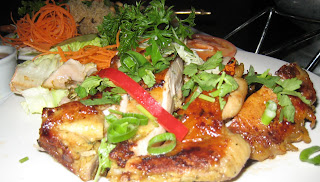Thai cuisine has evolved in the last few hundred years from simple boiled fresh vegetables and fish to incorporating rich assortment of spices from the South America, Persia and India. The most sophisticated culinary skills are demanded of chefs preparing royal or palace cuisine. Though the Chinese Thais only make up less than 10 per cent of the Thai population, their influence in Central Thailand is strongly felt in the economy and cuisines. Many Chinese dishes have become favourites on the Thai menu for daily home cooking, street food and banquets. Traditionally, the Thais eat with their hands but the Chinese and Europeans introduced utensils such as chopsticks and spoons. Most foreigners who love Thai cuisine probably do not know that some their favourite foods are Chinese in origin -- noodles, canapés and seafood dishes. Most ethnic Chinese living in Thailand are Teochew who originated from Shantou (Swatow) in Guangzhou have shaped the tastes of Chinese Thai cooking. However, you would also notice influences from Hainan, Hakka and Cantonese cooking. A safe guess is that if the dish is not spicy, curry or grilled, it is probably Chinese in origin. Did you know these are Thai Chinese dishes?
Thai Chinese CuisineAppetizersPorpiah Tod (deep fried spring roll)
Hoy Chor (hey chou in Teochew, minced meat and prawn wrapped in soy skin and deep fried)
Chicken, peanut and coconut in a bundle (also named “money bag”)
Chicken wrapped with pandan leaf (kai hor bai toey)
Tod Mun Pla (spicy fried fish cake)
Tod Mun Goong (chilli prawn cake)
Noodle SoupTom chuet wunsen (glass noodle soup)
Rad Na (the same as Chao Hor fun - fried flat rice noodle with sweet soy sauce, meat, seafood, kailan and topped with thick gravy)
Phad See Ewe (Stir fry noodle, derived from the Teochew word for soy sauce)
Kway Teow Soup (flat rice noodle in chicken or beef soup)
Neua Dun (double boiled beef soup with herbs) can be used as a base for noodle (similar to pho)
SeafoodPeh Sar (generic term for cooking seafood on a steamer with lighted candle at the table)
Pla nueng manao - steamed fish with sour plum and spicy lime juice dressing.
Pla Nung Khing Sai Het - Steam fish with ginger and mushroom slices
Krapow Pla Nam - Fish maw soup
Yen To Foo – stuffed tofu with fish paste dipped in red sweet sauce
PoultryGai phat met mamuang (Chicken stir fry with cashew nut in roast chilli sauce)
Kung Pao Chicken (chicken stir fry with dried chicken and peppercorn)
Kai phat khing - chicken stir-fried with sliced ginger.
Rice DishesKhao Mun Gai (steamed chicken rice)
Kao Pad Nahm Liap : Black Olive and Minced Pork Fried Rice
Khao Phat : Fried Rice with Egg and Chicken
Khanom Jeen (Chinese rice noodles, i.e., fresh round rice noodles normally use in cooking laksa)
Khanom (a generic term for many types of steam dumplings, small buns and cakes) – most with savoury filling are Chinese.
Chok (rice congee that has been boiled for long hours)
Khao Thom – soupy rice porridge either boiled with meat or plain and eaten with dishes.
VegetablesPhak bung fai daeng: fried water spinach / morning-glory / kangkong
Phak khana mu krop - khana (gailan) stir fried with crispy pork.
Suki - a Thai variant of the Chinese / Japanese hot pot.
Thai NoodlesLad Na - Rice noodle with a meat and brocoli sauce poured on top. (Fried hor fun in egg and starchy gravy)
Pad Sieu - Thick Rice noodle colored by sweet black soy sauce with egg, brocoli and meat.
Ba Mee Moo Daeng - Egg noodle with Chinese red pork.
Ba Mee Loog Chin - Egg noodle with meat balls.
Goui Thieu Loog Chin - Rice noodle with meat ball, either with sauce or broth.
Guoi Thieu Lod - Rolled rice noodle with meat and broth.
Pad Thai - Fried rice noodles with shrimp, chives, tofu, salty radish, egg, beansprouts, sprinkled with ground peanut & chilli.
Lad Na Neua Sup - Rice noodle with spicy stewed beef soup
- c.g.
Copypright Reserved
Permission required for republishing




